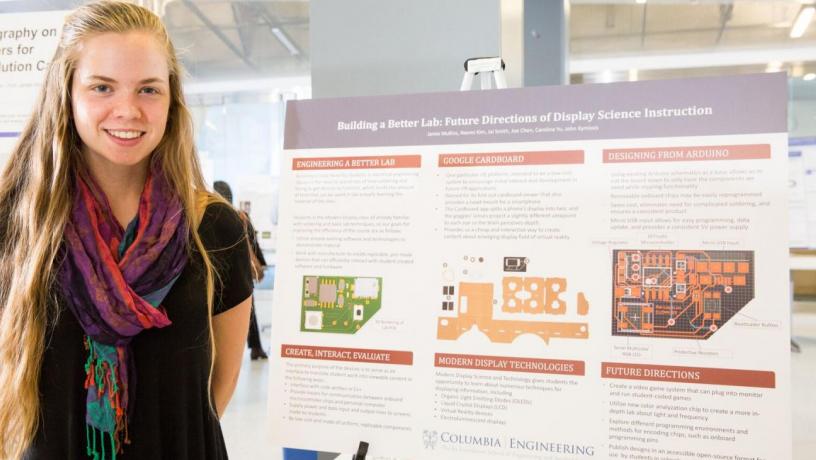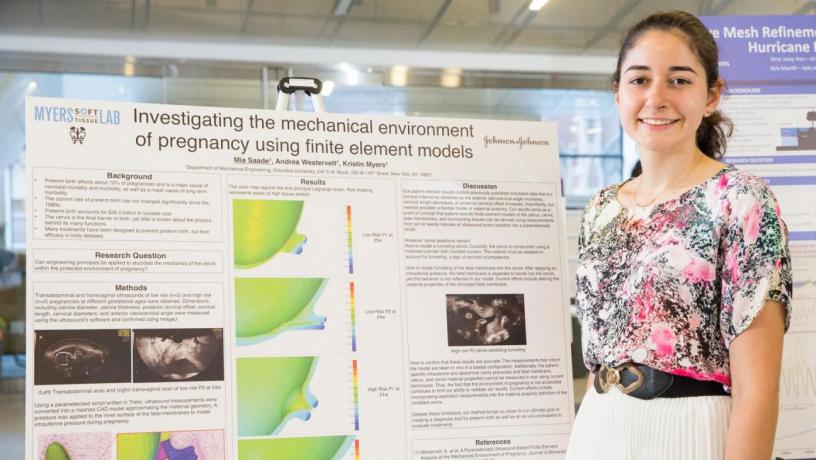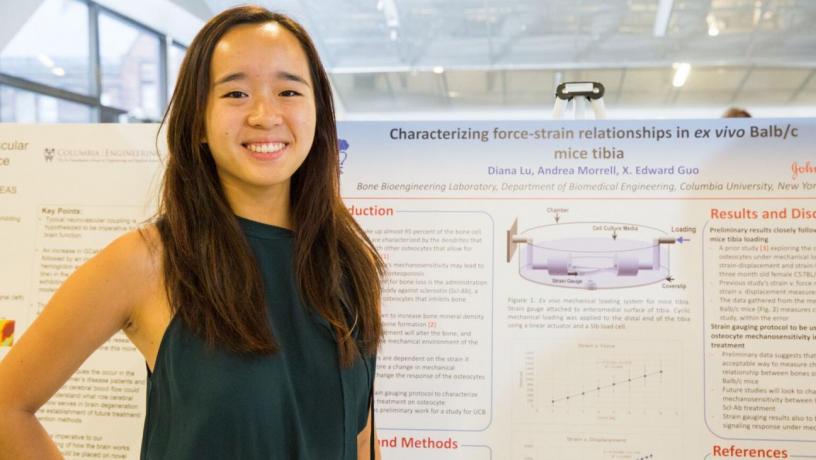Building the Pipeline
A new summer internship program gives undergraduate women lab experience—and a network to carry them forward in the field.

Christine Hendon (left), an assistant professor of electrical engineering pictured here in her lab, was among the faculty members who worked with J&J Scholars Program participants this past summer.
The best innovations arise from engaging the brightest talents across the broadest swath of the population. That principle is put into practice at Columbia Engineering, which has been recognized for its impressive track record in bringing women into the field: for example, at 49 percent female, the undergraduate class of 2021 dramatically outpaces similar programs at other schools. Now, a new research initiative wants to build on that success. The Johnson & Johnson Scholars Program, which debuted last summer, was designed to help women build thriving engineering careers—and to create a powerful network of support that enriches the engineering field as a whole.
The initiative was born when biotech giant Johnson & Johnson (J&J) approached Columbia with a common interest: increasing the number of women entering STEM fields and retaining those women as they grow in their careers. The result was the J&J Scholars Program, which provides competitively funded stipends to undergraduate women interested in remaining on campus to work full time in faculty labs or on mentored research projects over the summer break.
“I’ve seen firsthand how necessary it is to create mechanisms of support for women interested in STEM careers,” said Georgia Papathomas PhD’78, a vice president and group CIO at J&J who also serves on the School’s Board of Visitors. “This project was a way to address systemic issues in a meaningful way. At Johnson & Johnson, we understand how diversity fosters a dynamic workforce, and by partnering with Columbia Engineering, we knew we could make a positive impact on the career trajectory of some exceptional young women.”
“It’s an ongoing issue: how to not just get more women into STEM but how to retain them and give them opportunities to rise through the ranks,” said Leora Brovman, associate dean for undergraduate student affairs. “Having these kinds of positive opportunities at such a young age could position more young women in the field in the future.”
Integrated into the Summer@SEAS enrichment program, the 19 women in the J&J Scholars Program participated in all Summer@SEAS’s weekly seminars and presentations on critical topics. They went on a site visit to J&J’s facilities in New Brunswick, New Jersey, as well. They also met regularly at joint lunches with women faculty and grad students, gaining a chance to learn about different career paths and professional experiences directly from women in the field and, just as important, to ask questions.
That combination of in-lab experience and out-of-lab support was powerful, students remarked.
“I didn’t know much about labs, but what struck me was how nice everyone was and how willing they were to explain what they were doing,” said Jessie Yan ’20SEAS, who worked on the Collisionless Terrella Experiment at the Columbia Plasma Physics Lab under Professor Michael Mauel and PhD student Mel Abler. “I met a lot of really great people throughout the program whom I still keep in touch with. And in meeting other women doing research at different levels, you realize you’re not quite so alone.”
Sofia Barbosa ’20SEAS worked in the Cellular Engineering Laboratory under Professor Clark Hung and research scientist Dr. Andrea Tan. She said the J&J Scholars Program opened her eyes to potential professional paths.
“I was interested in the research I was doing, and I was getting to enjoy research, in and of itself,” she remarked. “And at the site visit, meeting people who have those careers, I could learn more about getting a job in industry.”
For Jamie Mullins ’20SEAS, who spent her summer at the Columbia Laboratory for Unconventional Electronics under Professor John Kymissis, the connections the program fostered have been invaluable.
“The program didn’t hold our hand, but it gave us relevant resources to help us really ask the questions we needed,” she said. “To talk to women whom you look up to and who are successful; that was really great. And now I have these other girls I’ve met as part of my network.”
As the program looks to its second year, Brovman said the mentoring aspect will deepen. J&J Scholars will continue to work closely with faculty, but they’ll also be speaking with some of the high school students doing their own research programs on campus.
“I think it’s good for the undergrads to receive the mentorship, then also to offer a similar version to younger people, to engage them in their interest early on,” Brovman observed.
In fact, that chain of influence is exactly what the program is intended to foster, she said.
“These kinds of programs are where we build the pipeline to retain the undergrads within the STEM fields—these kinds of experiences encourage some of them to move forward into academia,” Brovman remarked. “And that’s a part of the pipeline that does need to be developed. Many students do go on to industry and to other fields, and giving students the opportunity to participate in research and learn what that life is will also serve to help some of them clarify that that’s what they love to do.”
It’s an ongoing issue: how to not just get more women into STEM but how to retain them and give them opportunities to rise through the ranks.

Jamie Mullins ’20SEAS spent her summer at the Columbia Laboratory for Unconventional Electronics working under Professor John Kymissis.

Mia Saade ’19SEAS focused on translational research while in Professor Kristin Myers’s lab.

Through the program, Diana Lu ’19SEAS was able to extend a previous research project in Professor Ed Guo’s Bone Bioengineering Lab under the mentorship of PhD student Andrea Morrell.
